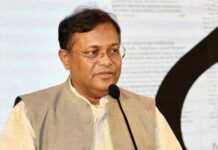Over 1.5% people of the country live in slums across the country, says a recently released population census data.
The census on slum dwellers and floating population conducted by the Bangladesh Bureau of Statistics (BBS) from April 25 to May 2 last year said 2.23m people live in slums.
As per the data, the population living in slums rose by 60.43% over the last 17 years. The figure was 1.39m in 1997.
The number of floating population has, however, declined sharply. The census found 16,621 floating people during the same period.
Of them, 1.14m are male, 1.09m female and 1,852 transgendered people.
The census report attributed the people’s migration to cities to that of lack of job opportunities in remote areas and poverty over the last 17 years.
The literacy rate in slums is 33.26%, says the census data.
The census defines a slum as “residential areas where dwellings are unfit for human habitation” because they are dilapidated, cramped, poorly ventilated, makeshift, unclean, or “any combination of these factors which are detrimental to the safety and health” and covers nine cities of the country.
Most of those come to cities after losing their ancestral land due to river erosion, poverty and other reasons take shelter in unhealthy and densely populated slums.
Of the total slum population, 50.96% come to cities in search of jobs, 28.76% for poverty and 7.04% after losing their land and houses to river erosion.
The number of slums across the country is 13,943. Of which, 3,399 in Dhaka, 2,208 in Chittagong, 1,287 in Gazipur, 1,143 in Khulna, 667 in Sylhet, 137 in Barisal, 103 in Rajshahi, 49 in Rangpur and 41 in Comilla.
The census also shows 1.06m slum dwellers live in Dhaka, 635,000 in Chittagong, 172,000 in Khulna, 120,000 in Rajshahi, 118,000 in Rangpur, 91,630 in Sylhet and 49,401 in Barisal divisions.
More than 27.25% slum dwellers own houses, 64.87% live in rented houses and 6.99% without paying any rent.
Of the slum dwellers, 89.65% have access to electricity, 9.7% use kerosene lamps and 0.33% solar power.
About drinking water, it said 52.48% use tube-well water and 45.21% depend on supply water. Over 42.19% use unhygienic toilets and 26.25% sanitary latrines.
While 17.88% of the shanty people are housewives, 13.33% students, 13.18% garment factory workers, 7.58% traders, 6.92% rickshaw-pullers, 6.71% job holders and 6.41% domestic helps.
The government first carried out a partial slum census in four major cities – Dhaka, Chittagong, Khulna and Rajshahi in 1985-1986.
The first full slum census was conducted across the country in 1997 when the BBS found that there were 2,991 slums in four major city corporations where 1.39m people lived and the Dhaka city had 1,000 slums.
According to BBS Health and Morbidity survey 2014, the country’s 29.58% people are smokers.
Among adult people (18-64 age), 77.68% are married, 21.34% unmarried and among adult female, 85.2% are married and 7.45% unmarried.
Source: Dhaka Tribune









